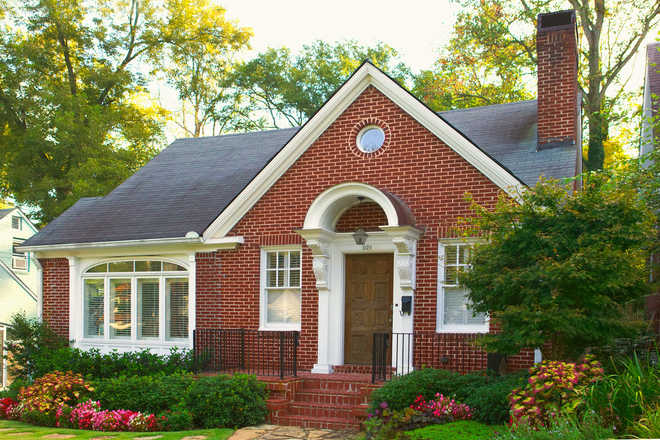Brick by brick, a house is built
Jagvir Goyal
WE really can’t do without bricks while building our house. In ancient times, bricks were extensively used in construction of forts. Today also, almost all buildings use bricks one way or another. Even if we adopt earth-quake resistant, framed structure design for our house, bricks are used to fill up the space between beams and columns to act as walls. Only few builders have switched over to concrete blocks. Otherwise, bricks continue to dominate as the main construction material.
From old times: Bricks that are mostly used by builders are burnt clay bricks that are red in colour, nine-inch long, three-inch thick, 4 ½ inch wide and are available at the brick kilns. Only clay is used in the manufacturing of these bricks. Selection of burnt clay bricks has to be done carefully.
All bricks produced by a kiln are not of good quality. Some bricks may have received full heat while others may have not. The bricks that give a ringing sound when struck against each other promise quality. Such bricks are hard and free from cracks and produced by using good earth. Bricks made out of sandy soils do not produce good ringing sound.
Bricks are sold in numbers and a smaller size may result in over consumption, causing extra expenditure. Exact size of a brick is 9”X4” 3”/8”X2” 11”/16”. Smaller-sized bricks cause problems during masonry work. The size of the frog, commonly called dabbi in the brick is 4”X 1 ½”X¼” or 100 mm X 40 mm X 6mm. It carries manufacturer’s mark on the inner side. The faces of the bricks should be smooth and corners should be sharp, not blunt or broken. Distorted bricks, even if well burnt and deep red in colour, should be avoided.
Variation in size of bricks should always be avoided as masons find it difficult to maintain the lines and levels in masonry work. One should prefer bricks from one kiln only. Though bricks are porous material, yet those having minimum possible water absorption property should be chosen. IS code for these bricks is IS1077.
Though burnt clay bricks remain most popular, there are some other types of bricks available in the market as well. Some of these are:
Clay fly ash bricks: While only clay is used in burnt clay bricks, 25 to 30 per cent of fly ash is mixed with the clay before their burning in the kiln to produce clay fly ash bricks. Burnt clay fly ash bricks have better strength and properties than the normal burnt clay bricks. All test results of these bricks are better than those of normal burnt clay bricks. The only bottleneck in their production is that machinery is required for proper blending of fly ash with clay while burnt clay bricks can be produced by hand moulding only. As the brick kiln owners are reluctant to invest in machinery, clay fly ash bricks are not easily available. These bricks have least water absorption property. The IS code for these bricks is IS 13757.
Fly ash lime bricks: Fly ash lime bricks don’t use clay but lime, sand and fly ash. These are not burnt like clay bricks or clay fly ash bricks. The lime used in these bricks should only be C class, hydrated lime as per IS 712. The IS code for these bricks is IS 12894. These are generally prescribed for buildings having less than two storeys. Their strength and water absorption percentage is almost equal to that of burnt clay bricks. These are cheaper than burnt clay bricks.
Sand lime bricks: These bricks are similar to fly ash lime bricks, except that in these bricks fly ash is replaced by sand. Only sand and lime are used to make these. These bricks are also not burnt in a kiln. Their properties are similar to fly ash lime bricks, except weight, as fly ash is a lighter material. While a fly ash lime brick weighs around 2.4 kg, a sand lime brick weighs around 2.8 kg. These are produced in the same standard size. These are produced conforming to IS 4139.
Fire clay refractory bricks: These bricks are of two types. One are moderate-hea duty fire clay refractory bricks and others are high-heat duty fire clay refractory bricks. Moderate-heat duty bricks conform to IS 6 and high-heat duty bricks conform to IS 8. Their crushing strength is much higher than that of normal burnt clay bricks. Also, their water absorption is lesser than that of normal bricks. These bricks are produced mechanically and heavy machinery cost has to be incurred to set up a plant for their manufacturing. These cost almost five to six times the cost of normal bricks. Thus these are not suitable for use in residential houses.
Perforated bricks: Perforated bricks were initially produced in larger sizes by some mechanised brick plants of the south and looked promising. But these couldn’t be put to use in North India due to large transportation cost involved. Now plants of perforated bricks have come up in many cities of Punjab and Haryana and these are increasingly being used. The size of the perforated bricks is same as that of burnt clay bricks and despite their being perforated, these are suitable for load-bearing walls. Their crushing strength is much higher than that of normal bricks, water absorption is much lower. Conforming to IS 2222, these bricks have attractive and smooth finish because of their mechanised production and burning in special energy efficient kilns.
(The writer is Engineer-in-Chief, Civil Engineering Department in a Punjab PSU)
Types of bricks
- Clay fly ash bricks
- Fly ash lime bricks
- Sand lime bricks
- Fire clay refractory bricks
- Perforated bricks
- Types of concrete blocks
- Solid or hollow concrete blocks
- Hollow clay blocks
- Autoclaved aerated blocks









